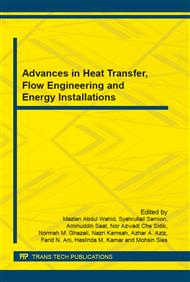[1]
Sforza, D.M., C.M. Putman, and J.R. Cebral, Computational fluid dynamics in brain aneurysms. International Journal for Numerical Methods in Biomedical Engineering, 2012. 28(6-7): pp.801-808.
DOI: 10.1002/cnm.1481
Google Scholar
[2]
Sforza, D.M., C.M. Putman, and J.R. Cebral, Hemodynamics of cerebral aneurysms. 2009. pp.91-107.
Google Scholar
[3]
Augsburger, L., et al., Methodologies to assess blood flow in cerebral aneurysms: Current state of research and perspectives. Journal of Neuroradiology, 2009. 36(5): pp.270-277.
DOI: 10.1016/j.neurad.2009.03.001
Google Scholar
[4]
Cavazzuti, M., et al., Non-Newtonian and flow pulsatility effects in simulation models of a stented intracranial aneurysm. Proceedings of the Institution of Mechanical Engineers, Part H: Journal of Engineering in Medicine, 2011. 225(6): pp.597-609.
DOI: 10.1177/09544119jeim894
Google Scholar
[5]
Wang, S.Z., et al., Non-newtonian computational hemodynamics in two patient-specific cerebral aneurysms with daughter saccules. Journal of Hydrodynamics, 2010. 22(5): pp.639-646.
DOI: 10.1016/s1001-6058(09)60098-6
Google Scholar
[6]
Cavazzuti, M., et al., Beyond the Virtual Intracranial Stenting Challenge 2007: Non-Newtonian and flow pulsatility effects. Journal of Biomechanics, 2010. 43(13): pp.2645-2647.
DOI: 10.1016/j.jbiomech.2010.04.042
Google Scholar
[7]
Fisher, C. and J.S. Rossmann, Effect of non-Newtonian behavior on hemodynamics of cerebral aneurysms. Journal of Biomechanical Engineering, 2009. 131(9).
DOI: 10.1115/1.3148470
Google Scholar
[8]
Hashimoto, T., H. Meng, and W.L. Young, Intracranial aneurysms: links among inflammation, hemodynamics and vascular remodeling. Neurological research, 2006. 28(4): p.372.
DOI: 10.1179/016164106x14973
Google Scholar
[9]
Chiu, J. -J. and S. Chien, Effects of disturbed flow on vascular endothelium: pathophysiological basis and clinical perspectives. Physiological reviews, 2011. 91(1): pp.327-387.
DOI: 10.1152/physrev.00047.2009
Google Scholar
[10]
Valen-Sendstad, K., K.A. Mardal, and D.A. Steinman, High-resolution CFD detects high-frequency velocity fluctuations in bifurcation, but not sidewall, aneurysms. Journal of Biomechanics, 2013. 46(2): pp.402-407.
DOI: 10.1016/j.jbiomech.2012.10.042
Google Scholar
[11]
Valen-Sendstad, K., et al., Direct numerical simulation of transitional flow in a patient-specific intracranial aneurysm. Journal of Biomechanics, 2011. 44(16): pp.2826-2832.
DOI: 10.1016/j.jbiomech.2011.08.015
Google Scholar
[12]
Lee, S.W., et al., Importance of flow division on transition to turbulence within an arteriovenous graft. Journal of Biomechanics, 2007. 40(5): pp.981-992.
DOI: 10.1016/j.jbiomech.2006.03.024
Google Scholar
[13]
Lee, S.W., et al. Direct simulations of transitional flow in a patient-specific carotid bifurcation with stenosis. 2008. Novosibirsk-Tomsk.
Google Scholar
[14]
Fisher, C. and J.S. Rossmann, Effect of Non-Newtonian Behavior on Hemodynamics of Cerebral Aneurysms. Journal of Biomechanical Engineering, 2009. 131(9): pp.091004-091004.
DOI: 10.1115/1.3148470
Google Scholar
[15]
Takao, H., et al., Analysis of cerebral aneurysms using Computational Fluid Dynamics (CFD). Japanese Journal of Neurosurgery, 2012. 21(4): pp.298-305.
Google Scholar
[16]
Frösen, J., et al., Saccular intracranial aneurysm: pathology and mechanisms. Acta Neuropathologica, 2012: pp.1-14.
Google Scholar


